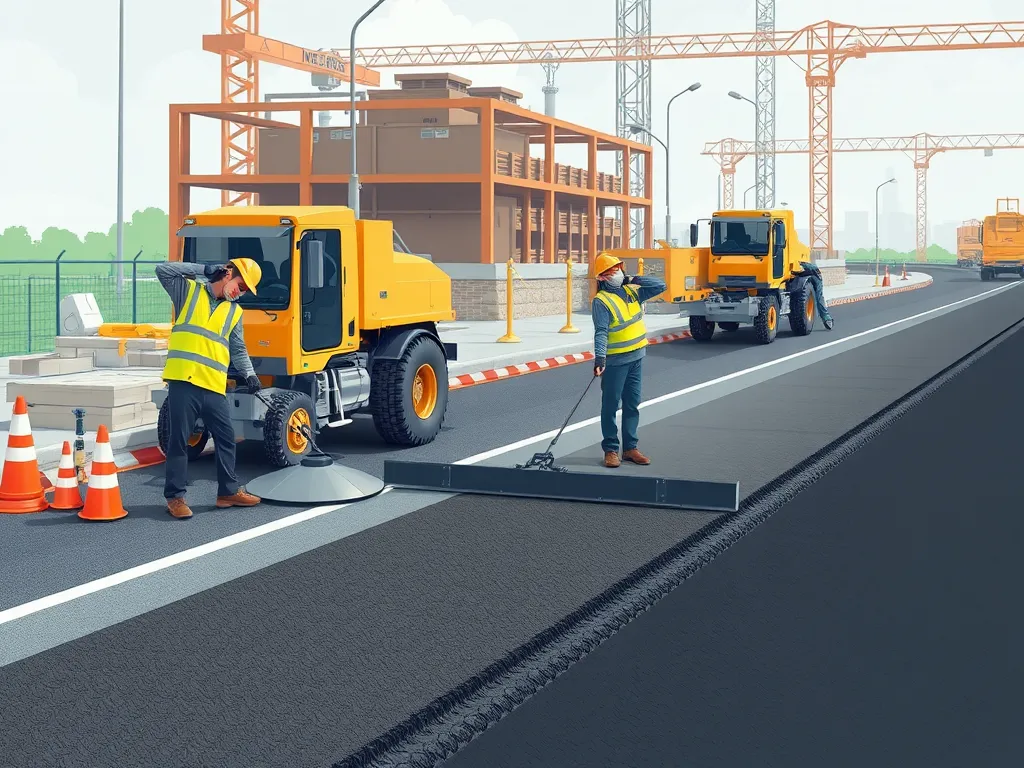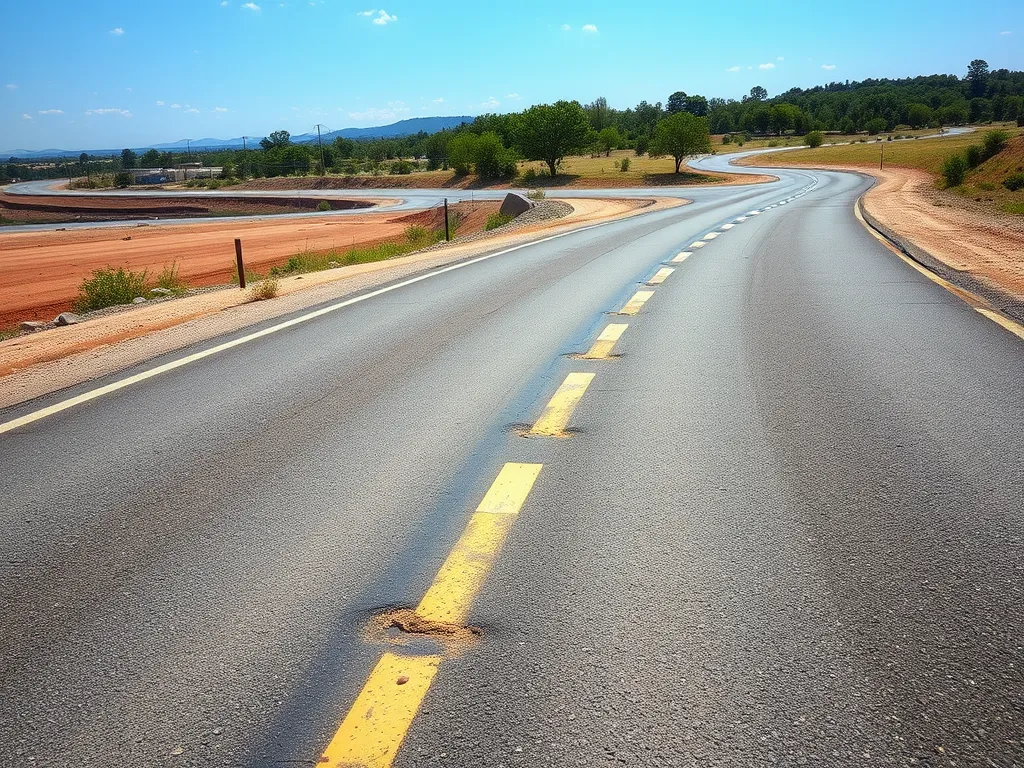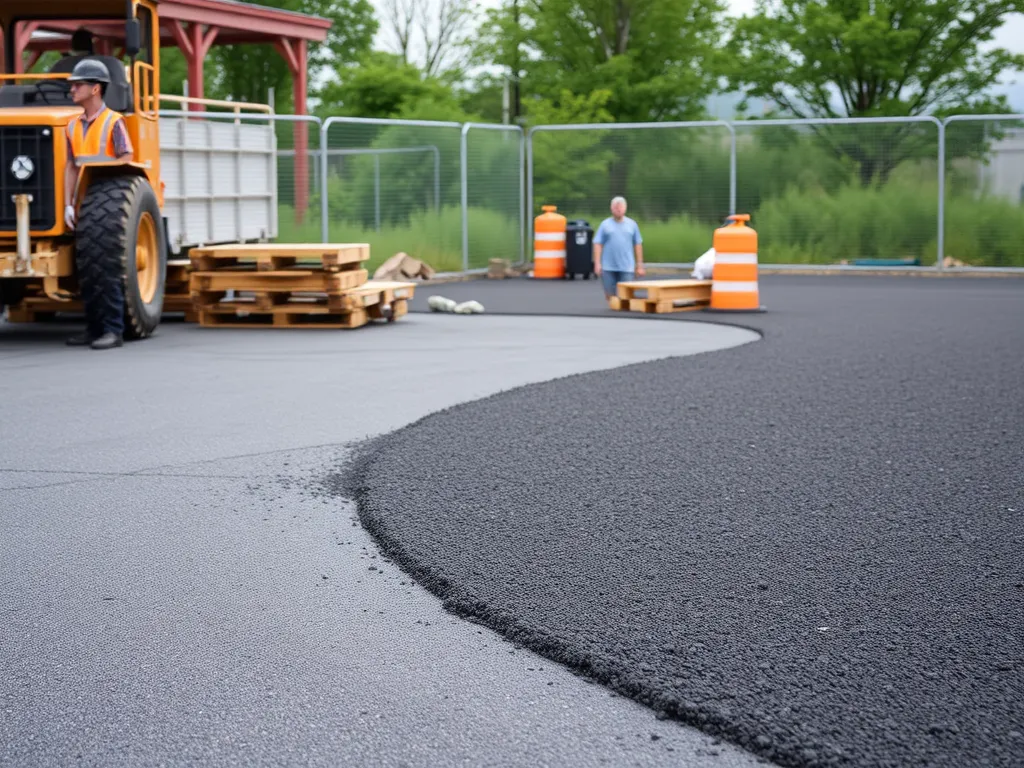Cost Savings With Asphalt Paving
Published on: November 9, 2025 | Last Updated: April 14, 2025
Written By: George Voss
Asphalt paving cuts costs for driveways, roads, and parking lots better than concrete or gravel. It costs 30-50% less upfront than concrete and requires fewer repairs over time. Gravel may seem cheaper initially, but asphalt lasts 3x longer with proper maintenance. Budget-conscious projects benefit from asphalt’s faster installation (2-3 days for most driveways) and lower lifetime expenses.
This article shows how asphalt outperforms other materials in price and durability. You’ll see cost comparisons per square foot, learn why maintenance savings add up, and get tips to plan projects like 20×20 driveways or 1,000 sq ft lots. We’ll also explain how recycling old asphalt and energy-efficient production methods boost long-term savings.
Contents
Asphalt Vs. Other Paving Materials: Cost Comparison
Choosing a paving material impacts both short-term budgets and long-term finances. Asphalt stands out for its balance of affordability and lasting performance. Let’s break down how it stacks up against common alternatives.
Asphalt Vs. Concrete: Initial and Long-term Costs
Asphalt installation runs $2-$5 per square foot, while concrete costs $4-$8. This 40-50% upfront saving makes asphalt a go-to for large projects like parking lots or roads. Though concrete lasts 25-40 years, its rigid structure cracks under soil shifts or freeze-thaw cycles. Fixing a cracked slab can hit $8-$12 per square foot. Asphalt’s flexibility handles stress better, and minor cracks cost just $1-$3 per square foot to fill. Annual sealcoating ($0.15-$0.25 per sq ft) adds 10-15 years to its lifespan, keeping long-term costs low.
Asphalt Vs. Gravel: Durability and Maintenance Expenses
Gravel’s $1-$3 per square foot price tag looks tempting, but hidden costs add up. Roads or driveways need regrading 1-2 times yearly, plus fresh gravel layers to combat erosion. A 300-foot gravel driveway might cost $800 annually to maintain. Asphalt requires minimal upkeep after installation. Its solid surface also cuts vehicle wear—gravel roads boost tire replacement rates by up to 30%. For high-traffic areas, asphalt’s 15-20 year lifespan often makes it cheaper within 5-7 years.
Looking beyond material comparisons, several factors amplify asphalt’s financial upside. Up next: how local pricing, labor tactics, and maintenance routines lock in savings.
Factors Influencing Asphalt Paving Cost Savings
Four main factors shape financial outcomes in asphalt projects. From raw material pricing to long-term upkeep, smart planning turns initial spending into lasting value.
Material Costs and Availability
Asphalt mixes contain 90-95% stone/sand aggregates and 5-10% bitumen binder. This composition keeps material costs 30-40% below concrete. Local quarry access cuts transport fees—a key reason asphalt averages $2-$5 per square foot versus concrete’s $4-$8.
Recycled Asphalt Pavement (RAP) reuses 100% of old material, trimming new aggregate needs by 20-30%. Many states mandate 15-30% RAP in mixes, saving $8-$15 per ton. Stockpiling crushed material on-site avoids disposal fees up to $70 per load.
Installation Speed and Labor Impact
Hot-mix asphalt cures in 24-48 hours, unlike concrete’s 7-day wait. A 10-person crew can lay 500 tons daily—enough for 1.25 miles of single-lane road. Fast-track methods like infrared patching fix potholes in 20 minutes versus 4-hour concrete pours.
Night paving on highways avoids $15,000 daily traffic control costs. Batch plants within 30 miles prevent mix cooling, saving $200-$500 per load in fuel. Proper planning trims labor hours by 15-25% compared to alternative materials.
Long-term Maintenance Differences
Sealcoating every 3-5 years at $0.25-$0.50 per sq ft prevents 80% of cracks. Concrete joints need $3-$7 per linear foot repairs annually. Infrared repairs cost 60% less than full-depth patches—$75 vs $200 per square yard.
Proper drainage design adds 7-12 years to pavement life. Crack sealing within 6 months of forming stops 90% of water damage. Preventive care slashes lifecycle costs by 35-50% over 20 years versus reactive fixes.
Grasping these factors aids planning, but actual savings hinge on accurate project budgeting—a topic we’ll unpack next.

Calculating Asphalt Paving Expenses
Accurate cost calculations form the backbone of asphalt paving budget savings. Precise estimates prevent overspending while ensuring material quality and project longevity.
Asphalt Cost Calculator: Estimating Project Budgets
Specialized asphalt cost calculators factor in three primary variables: material prices ($90-$150 per ton), labor rates ($50-$80 hourly), and site preparation needs. These tools adjust for regional price fluctuations and layer thickness requirements. A 2-inch overlay costs 20% less than a 4-inch base layer due to reduced aggregate use. Always add a 7-10% contingency for drainage adjustments or soil stabilization.
Cost Per Square Foot for Driveways and Parking Lots
Residential driveways average $2.50-$4.50 per square foot, while commercial parking lots range $1.50-$3.00. Bulk projects slash per-unit costs—paving 10,000 sq ft drops prices by 15% compared to 1,000 sq ft. PG 64-22 binders (common in temperate climates) add $0.30/sq ft but extend pavement life by 3-5 years.
20×20 Driveway Cost Breakdown
A 400 sq ft driveway typically costs $1,400-$1,800: – Materials: 3 tons at $120/ton = $360 – Labor: 8 hours at $65 = $520 – Base preparation: 6 inches crushed rock = $240 Recycling existing asphalt cuts material costs by 30%. Scheduling installations during off-peak seasons (November-March) may reduce labor fees by 12%.
1000 sq ft Paving Project Estimates
Commercial-grade 1,000 sq ft lots average $2,250-$2,700: – Hot-mix asphalt: 12.5 tons at $100 = $1,250 – Compaction/sealing labor: $750 – Geotextile fabric sublayer: $250 Superpave mix designs improve load distribution, lowering long-term repair costs by 18% compared to traditional mixes. Using infrared patching for repairs saves $4.50 per sq ft versus full-depth replacement.
With precise budgeting strategies in place, let’s explore how these upfront savings multiply over decades through reduced maintenance and adaptive reuse.
Also See: Can You Pressure Wash Oil Stains Off Asphalt? Be Cautious
Long-term Financial Benefits Of Asphalt
Asphalt’s financial edge grows over time through reduced repairs, adaptable maintenance, and decades of service. Let’s break down how it outperforms other materials in lasting value.
Lower Repair Costs Compared to Concrete
Asphalt repair averages $0.50 per linear foot for crack filling, while concrete slab replacement costs $3-$5 per square foot. Asphalt’s flexibility resists freeze-thaw damage better than rigid concrete, cutting crack frequency by 25-40%. Patching potholes costs 60% less than replacing concrete sections. Quick fixes take hours instead of days, minimizing labor fees.
Cost-effective Resurfacing and Sealcoating
Resurfacing worn asphalt costs $1.50-$3 per square foot versus $4-$7 for full replacement. Adding a fresh 1.5-inch layer every 10-15 years restores smoothness without removing old layers. Sealcoating every 3-5 years at $0.15-$0.25 per sq ft blocks oxidation and water penetration. This combo extends pavement life 30% while keeping annual budgets predictable.
Extended Lifespan With Proper Maintenance
Well-maintained asphalt lasts 20-30 years – doubling gravel’s lifespan and matching concrete’s durability at half the initial cost. Routine sealcoating, crack sealing, and drainage checks prevent 80% of premature failures. Budgeting $500-$1,000 annually for upkeep avoids $15,000+ reconstruction bills. Projects using PG 64-22 binders see 40% fewer surface defects over 20 years.
These strategies position asphalt as a long-term ally for budget-conscious projects. Next, we’ll explore how its eco-friendly traits amplify financial gains.

Environmental and Secondary Cost Advantages
Beyond direct paving expenses, asphalt delivers hidden financial gains through eco-friendly practices that slash long-term project costs.
Recyclability Of Asphalt Materials
Asphalt stands as North America’s most recycled material – 100% reusable through milling and reprocessing. Reclaimed Asphalt Pavement (RAP) mixes with fresh binder to create roads at 20-30% lower material costs. Contractors save $15-$25 per ton using recycled mix versus virgin materials.
Recycling cuts mining needs by 60% for aggregate materials and reduces transportation fuel use. Many states offer tax credits for RAP projects, while LEED-certified builds gain points for recycled content. This circular economy model turns old parking lots into budget-friendly paving solutions.
Energy Efficiency in Production and Installation
Modern asphalt plants use 25% less fuel than 1970s models, with production temps now averaging 300°F versus concrete’s 400°F requirements. Warm-mix asphalt technologies (200-250°F) lower energy use by 20% through additives like zeolites or chemical emulsions.
Faster installation slashes labor costs – crews can lay 500+ tons daily versus 300 tons for concrete. Infrared patching repairs last 7-10 years using 40% less energy than traditional methods. These efficiencies help contractors pass savings to clients while meeting EPA emissions standards.
These environmental benefits raise common questions about balancing eco-practices with asphalt paving budget savings – let’s address them head-on.
Frequently Asked Questions (FAQs)
What Are the Maintenance Costs for Asphalt Paving Over Time?
The maintenance costs for asphalt paving typically involve sealcoating every 3-5 years at a rate of $0.15-$0.25 per square foot. Additionally, minor repairs such as crack filling can cost around $0.50 per linear foot. These relatively low upkeep costs can lead to significant savings compared to other materials over the lifespan of the pavement.
How Does the Lifespan Of Asphalt Compare to Other Materials?
Asphalt can last between 20 to 30 years with proper maintenance, which is comparable to the durability of concrete but generally at a lower initial cost. In contrast, gravel surfaces often need frequent regrading and replenishing, which can lead to higher long-term expenses despite lower upfront costs.
Are There Incentives for Using Recycled Asphalt Materials?
Yes, many states offer tax credits or financial incentives for projects that utilize Reclaimed Asphalt Pavement (RAP). Using recycled materials not only reduces material costs but also contributes to environmentally friendly paving practices, which can enhance project appeal and save money.
What Factors Can Increase the Overall Cost Of Asphalt Paving Projects?
Several factors can lead to increased costs in asphalt paving, including poor site conditions that require additional site preparation, the need for enhanced drainage systems, or unexpected repairs during the installation process. Accurately assessing these factors before starting a project can help in preparing a more precise budget.
Can Weather Conditions Affect Asphalt Paving Costs?
Yes, weather can significantly influence asphalt paving costs. Extreme temperatures, rain, or snow can delay installation and require additional time and labor to adequately prepare the site. Additionally, the curing process may be affected, potentially necessitating extra materials or protective measures.
How Do I Ensure Quality and Longevity in My Asphalt Paving Project?
To ensure quality and longevity, it is essential to work with experienced contractors who use high-quality materials, including proper binder types and mix designs. Additionally, following a strict maintenance schedule that includes crack sealing and sealcoating can significantly prolong the lifespan of your asphalt paving.

Closing Thoughts
Opting for asphalt paving offers significant cost savings compared to other materials. Its favorable initial cost, combined with lower long-term maintenance and repair expenses, makes it a smart choice for both residential and commercial projects. With the added benefits of recyclability and efficiency during installation, asphalt stands out as a sustainable and economical option.
By carefully analyzing project requirements and utilizing tools like our Asphalt Calculator USA, you can accurately estimate costs and maximize your investment. Making informed decisions now can lead to substantial savings in the future, reinforcing asphalt’s position as the go-to material for paving needs.
Useful References for You:
- The Asphalt Institute. (2007). MS-4: The Asphalt Handbook. Lexington, KY: Asphalt Institute.
- Current Asphalt Driveway Cost: A Comprehensive Pricing Guide for 2024 – Asphalt Industrial
- What Does Asphalt Driveway Paving Cost?
- How Much Does an Asphalt Driveway Cost in 2025?
- HOW MUCH DOES IS COST TO PAVE A DRIVEWAY?


